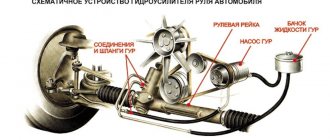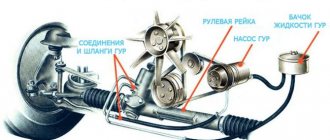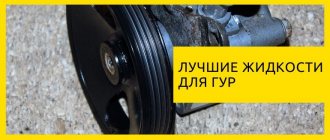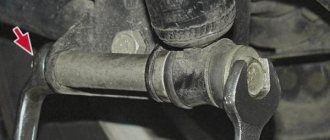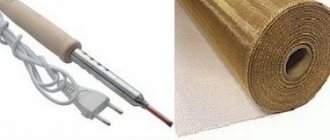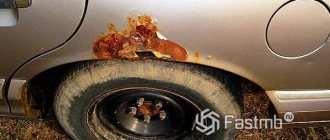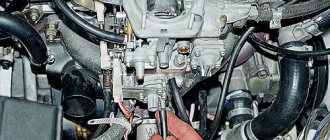Date of publication: April 26, 2021. Category: Automotive equipment.
Power steering (or abbreviated power steering) is a steering element designed to reduce the force a person has to turn the steering wheel. Thanks to this device, the life of car enthusiasts has become noticeably easier over the past few decades. In addition to the fact that power steering allows you to apply minimal effort to rotate the steering wheel, it also improves the maneuverability of the vehicle, as a result the driver feels more comfortable.
Like any other part of the car, the hydraulic booster can fail. You can repair it either at a car service center or yourself. Unlike installing electrics and auxiliary elements such as parking sensors or alarms, power steering requires extensive experience in such repair work. Therefore, if you are not confident in your abilities, it is better to turn to specialists, but if your skills allow you to do such work, then you can safely begin repairs. First of all, you need to make sure that the problem is in the hydraulic booster.
Power steering - design, why power steering is needed
The device of the power steering wheel
The power steering wheel is designed both to make it easier for the motorist to control the car when maneuvering on the road surface, and to soften impacts from damaged road surfaces and uneven surfaces. It is especially important that this device significantly reduces the risk of an accident when a tire ruptures, primarily for the front wheels.
The power steering is a closed hydraulic system, which consists of:
- A reservoir into which hydraulic fluid is filled.
- Pump.
- Pressure regulator.
- Control spool.
- Power cylinder.
Electrical power steering system
Power steering pump device and purpose
Power steering pump
Pumps of this type, designed for power steering, have a fairly high operating pressure, a maximum of 150 bar. Such a unit is driven by a belt that simultaneously turns the pump and the generator. Clearances set at the factory during assembly should be maintained within 0.005-0.01 millimeters. If the gap increases and exceeds the permissible value by 0.01 millimeters, there is a risk of a drop in pressure in the system at low speeds, which is felt on the steering column as an increase in load, or in the language of specialists - a “stiff” steering wheel.
Tension the power steering belt
To tension the power steering belt you will need:
- keys;
- jack;
- sandpaper;
- lantern or lamp;
- screwdriver.
Before tensioning the power steering belt, the car must be driven into a pit and the parking brake must be applied. After this, determine where the power steering is installed. If your car has a transverse engine, remove the front wheel from the pulleys and belts side. Raise the car on a jack and secure it. After that, follow these steps:
- Remove the protective apron from the motor. To do this, use a screwdriver to remove all the plastic clips, and then use a socket wrench to remove the existing mounting bolts.
- Using a flashlight, find where the power steering is attached, or rather, its adjusting bolt.
- Using a spanner, slowly turn the adjusting bolt until the belt is tight.
- Perform a voltage test. To do this, you need to grab the belt itself (between the pulleys) with your fingers, pull it back and quickly release it. If the belt makes a short and dull sound, it means you did everything correctly and the tension is optimal. If you hear a long and high-pitched “squeak”, this indicates excessive tension. In this situation, the belt needs to be loosened.
If you tighten the power steering belt too much, you risk damaging the bearings. It is better to stick to the optimal tension force, about 5-7 kilograms. You can check the tension force during operation; to do this, you need to press the belt in the middle with a force equal to 3-4 kilograms. If its length is short and the pulleys are located close to each other, then it should be pushed through by 3-5 millimeters. In the case when the distance is 40-50 centimeters, it should be pushed down by 1.5-2 centimeters.
The next power steering problem is pumping equipment.
Power steering pump, reasons for pump failure
The plate unit is considered a durable mechanism, but if it is used incorrectly, various emergencies may occur. Failure of a pumping unit is possible for a number of reasons, namely:
- Foreign impurities entering the system.
- Lack of fluid movement, as well as possible overheating of the hydraulic unit.
- Liquid leakage and a decrease in its level in the pipelines and tank.
- The working fluid has not been changed for a long time or a material is used that does not comply with the instructions for this unit.
To prevent this situation, it is necessary to monitor the liquid level in the tank weekly, and also check connections and pipelines for leaks.
Signs of power steering pump failure
The failure of the power steering pump is determined quite simply. These symptoms are immediately identified by the driver:
- The bearing starts to whistle. When the pump shaft is rocked and the belt is removed, play is detected.
- Liquid leakage is detected by characteristic spots on the road surface and engine components.
- When you rotate the steering wheel, an unpleasant extraneous sound appears.
- At idle or low speeds, increased forces appear on the steering wheel, compared to normal driving, when turning the wheels.
If such signs occur, the car owner must inspect the entire power steering system and decide whether the power steering pump requires repair, or whether it is necessary to pay attention to other parts of this structure.
How to bleed the power steering if there is an air lock
Before carrying out repair work, it is necessary to check the presence of fluid in the tank, as well as whether the brand of working fluid is approved for use on this vehicle. Often the cause of symptoms of a malfunction is the occurrence of air pockets in the system, to remove which it is necessary to pump the hydraulics. In this case, the performance of the power steering will be completely restored.
To remove air pockets, start the power unit, open the expansion tank cap and bleed the system by turning the steering wheel several times from one extreme position to the other. As the system is pumped, the liquid level in the tank will decrease. The procedure must be repeated until the liquid level is completely stabilized. Then add fluid to the required level.
Troubleshooting
So, we have figured out the reasons that require adjustment or restoration of the power steering. If it is necessary to replace the power steering belt, disassemble and repair the rack, or replace the power steering as a whole, then it is better to entrust such tasks to specialists. But if the malfunctions are minor, then you can adjust and repair the unit yourself.
- So, how to repair the system yourself? In principle, replacing the drive belt is not particularly difficult, but it all depends on the design features of the vehicle. In some cars, the drive belt is responsible only for the operation of the amplifier. In others, for example, Renault cars, the drive belt is responsible for the alternator, amplifier, and air conditioning, so replacing it will require some knowledge. You can purchase a power steering repair kit and replace the filter element or consumables. The latter, by the way, does not need to be changed so often - the replacement principle is quite simple, the old oil is drained and new oil is poured in, and care must be taken to ensure that no air pockets arise in the system during the process.
- It often happens that consumable fluid leaves the system, in this case repair is also required. The leakage itself, as a rule, occurs through a poor connection of pipes, shafts or bearings. You need to carry out a thorough diagnosis of all pipes and, if necessary, repair the power steering pipes.
- One of the most common malfunctions of this unit is pump failure. If you do not want to immediately go to the store and pay money for a new pump, the old one must be dismantled and disassembled. All elements of the device are cleaned from dust and dirt. There is a possibility that the problem lies in wear on the internal components of the case; a drill with a special attachment will eliminate this problem.
- Replacing the oil seal or bearing will be important if these elements are worn out. Installation of parts is carried out in the reverse order of removal. If you don’t know how to remove the power steering, the service book for your car will help you figure it out. The design features of all vehicles are different, so the dismantling instructions may have certain differences (video author - Auto Fix Info).
The service life of the power steering pump depends on the operating mode of the car and its model. For example, on a Peugeot 406 there are no problems with it for at least 300,000 km.
Therefore, it is necessary to replace or repair a part only when signs of a malfunction are detected (and to avoid their occurrence, check the fluid level in the power steering from time to time).
- Do-it-yourself repair of a VAZ 2110 radiator How to repair a VAZ 2110 engine cooling radiator with your own hands
- Do-it-yourself repair of the lower arm of the front suspension of a VAZ
- Repairing a Zhigulva classic heater using the example of a VAZ 2107 Do-it-yourself VAZ stove repair
- DIY muffler repair
Repairing the power steering pump (step by step instructions)
To dismantle the power steering pump and repair it yourself, you must perform the following steps:
- Lightly loosen the axial bolt securing the pump to the bracket, using the hole that is in the pulley. We completely unscrew the tensioner lock nut, and then remove the belt.
- Using a syringe, pump out hydraulic fluid from the tank. Turn the steering wheel left and right until it stops so that the lubricating fluid completely leaves the system. Do this several times until the pipes are completely clean.
- Loosen the clamp on the hose coming from the expansion tank. Then we remove this pipeline.
- We unscrew the bolt securing the high pressure hose, which goes into the system from the pump unit.
- We take out the axial bolt that secures the pump to the bracket, and instead insert a screwdriver or a metal rod of suitable diameter to lock the pulley. Next, unscrew the nut that secures the pump pulley.
- We pull the released pump up and place it in a specially prepared place. We remove oil and dirt from the device body.
- Using a puller, remove the bearing retaining ring.
- Unscrew the rear cover mounting bolts. Carefully pry it up with a small screwdriver and dismantle it, making sure that the rotor blades do not fall out of the housing.
- We take out the blades and place them on pre-prepared numbered pieces of paper so that nothing gets mixed up during assembly.
- Attention! Remember the location of the blades when assembled. It is necessary that during installation into the housing the rounded area of these blades should be turned outward.
- We remove the plate and all the parts that are under it.
- We knock out the shaft by carefully tapping it with a screwdriver.
- Press the bearing out of the pump shaft.
- We replace the unusable bearing with a previously prepared one.
- We check the pump parts for wear and defects. We clean surfaces from roughness and dirt. According to experts, simple cleaning of internal parts can reduce gaps and improve the operation of this unit without replacing any components.
- We do the assembly in reverse order. Be sure to replace the oil seal, O-rings, and washers with new ones prepared in advance.
Types of repair work
Not all necessary spare parts for do-it-yourself power steering repair are intended for open sale. When wondering how to repair power steering, you need to immediately understand that all operations are divided into three main categories.
- Protozoa. These include actions related to restoring the functionality of units lost for the following reasons:
- The working fluid loses its basic properties. This happens as a result of operating the hydraulic booster at temperatures that do not meet the permissible specifications, prolonged high loads, mixing incompatible types of working fluid, or untimely oil changes.
- Clogged channels and valves involved in the operation of devices.
- Medium difficulty. Small parts of the power steering itself and its pump, such as seals, seals, springs or valves, can most often be replaced if you can get new parts.
- High difficulty. Worn or damaged shafts, as well as seats of unit housings, must be repaired only in the factory. This requires a machine park and the availability of restoration technological equipment. As for new parts, their cost is high, so it is often much easier to purchase an assembled unit.
